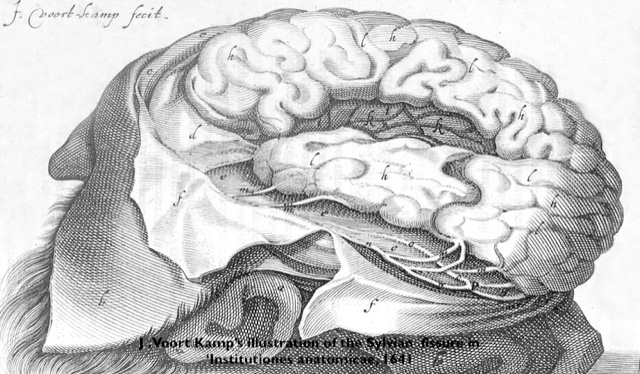Although the name Sylvius is perpetuated by a major cerebral fissure and by the interventricular aqueduct, it is less well known that subsequent to ancient Netherlands alcoholic concoctions, Sylvius distilled the juniper berry with spirits to produce an inexpensive diuretic medicine. It rapidly became popular. He first registered this as “genever”(gin) in 1650. It frequently caused outlandish behaviour, lampooned in William Hogarth’s engraving “Gin Lane.”

Franciscus de le Boë Sylvius (1614-1672) (Figure 1) was descended from a French family named de le Boë. His family moved to Germany where he was born in Hanau [1], but spent much of his life in the Netherlands. He read medicine at the University of Leiden. Coincident with the opening of the University of Amsterdam and with Rembrandt’s painting, The Anatomy Lesson, Sylvius began his studies in June 1632 and offered a disputation Positiones variae medicae in 1634. He obtained his doctorate at the University of Basel in March 1637, defending a thesis, De animali motu ejusque laesionibus. According to Albrecht Haller this contained the first description of the lateral cerebral fissure. Sylvius later fully described this fissure and the cerebral aqueduct in 1663 [2] (Figure 2).
He then studied the circulation of the blood and was able to show that it flowed through the blood vessels, pumped by the heart. With his professor, Johan Walaeus, he became a spirited proponent of Harvey’s de motu cordis (1628).

At Leiden University Franciscus Sylvius’s skills in teaching anatomy earned him fame: “many students, and certainly not the worst ones, attended his courses, so that it seemed as if only he could understand and explain anatomy.”
Though mainly devoted to the nervous system, he was the first to describe two kinds of secretory glands: conglomerate, made up of many smaller glands whose excretory ducts unite in a common one, as in the parotid and pancreas, and conglobate or ductless lymphatic clumped glands. In Opera Medica (1679) he demonstrated pulmonary tuberculosis and described how tubercles could progress to abscesses, cavities and empyema in phthisical, consumptive patients.
After nine years at Leiden he moved to Amsterdam in 1641. He practised there until in 1658 he returned to Leiden as Professor of Medicine, where he gave his inaugural lecture De Hominis Cognitione. An excellent, enthusiastic teacher he concentrated on the more common diseases in the Caecilia Hospital where Herman Boerhaave (1668-1738) subsequently taught medicine. Sylvius employed Socratic methods applying systems of diagnosis, prognosis, and therapy. He stressed the importance of autopsies as a way of proving or rejecting clinical diagnoses, as well as disclosing the pathology and possible mechanisms of disease.
As an accomplished physician, physiologist, anatomist and chemist, he initiated the 17th-century Iatrochemical School of Medicine [3]. Sylvius regarded as fundamental the effervescent reaction between acid and alkaline secretions, rejecting the classical notion of humours [1,3]. He devised drugs to counteract excesses. But he clung to the ancient notion of the spiritus animalis in the blood that was transported by the neck arteries to the capillaries (named by Leonardo da Vinci (1489–1515), their functions elaborated by Marcello Malpighi (1628–1694) and by Antonie van Leeuwenhoek (1632-1723)). The spiritus animalis passed through pores in capillaries into the cerebral cortex, thence permeated the white matter.
Thanks to his excellent teaching, Leiden flourished and attracted students from many countries. His Disputationem medicarum decas1 (1663) contained the theses of several of his students. Shortly before his death on 15 November 1672, Sylvius published the first volume of pathology entitled Praxeos medica idea nova (1671). His pupil Justus Schrader posthumously published the other volumes.
The fissure of Sylvius
Sylvius’s accurate study of the cortex emerged from his studies of the brain’s blood vessels. He is said to have dissected more than 300 human cadavers whilst in Leiden [4]. One of his students was Thoma Bartholini (1616-1680), son of the famous Copenhagen anatomist Caspar Bartholini. Twelve years after Caspar’s death Thoma published the 1641 edition of Caspar’s textbook, Institutiones anatomicae, nouis recentiorum opinionibus et obseuationibus. It is there that the Sylvian fissure was drawn by Sylvius, engraved by J Voort Kamp (Figure 2). Both Caspar Bartholini and Sylvius had shown and named the fissure separating the temporal lobe from the frontal lobe [5]. Sylvius had earlier made his observations in his thesis of 1637, but did not publish his description. He collaborated with Thoma Bartholini (known for his discovery of the human lymphatic system) in the revision of his father’s Institutiones anatomicae.
The lateral (Sylvian) fissure is the major groove that separates the superior temporal gyrus from the frontal lobe rostrally and the parietal lobe caudally. Within it lie the small convolutions of the island of Reil, or insula. Sylvius added to his description of the cortical fissures in the disputation De spirituum animalium in cerebro, cerebelloque confectione, per nervos distributione, atque usu vario, a thesis [6] defended by the student Gabriel Ypelaer under Sylvius’s supervision in 1660. The lateral fissure of Sylvius is described:
. . .the surface of the cerebrum is very deeply marked by gyri which are somewhat similar to convolutions of the small intestine. And especially noticeable is the deep fissure or hiatus which . . .begins at the roots of the eyes (oculorum radices) . . .it runs posteriorly above the temples as far as the origin of the brain stem (medullae radices) . . .It divides the cerebrum into an upper, larger part and a lower, smaller part. Gyri occur along the whole length and depth of the fissure even with the origins of smaller convolutions at the most superior part of it [6].
He later published his own drawings of the brain in 1663 in Sylvius’s Opera as Disputationes medicarum ad C Bartholini Institutiones Anatomica [6]. But Caspar Bartholini always gave priority to Sylvius for the discovery. Thoma Bartholinus, in 1640 valued highly Sylvius’s anatomical studies and remarked:
we can not pass over in silence the very accurate anatomist D. Franciscus Sylvius, since we borrow from his noble brain and ingenuity the admirable new structure of the brain.
Subsequent descriptions and illustrations of the Sylvian fissure and insula were given by Vicq d’Azyr in 1784 and by JC Reil in 1809 [7].
The aqueduct of Sylvius
The connection between the third and fourth ventricles had already been mentioned or suspected by Galen in De usum partium as a canal giving communication between the cerebrum and the cerebellum. Vesalius had clearly described it in De Fabrica… (1543) as an anus-like orifice of the meatus which extends from the third to the fourth ventricle below the quadrigeminal bodies (pp. 716-717) [7]. In chapter twenty-one of Sylvius’s Disputationes medicarum is described a canalis vel aquae-ductus between the conjoined roots of the spinal cord and under “the bridge” (pons Varoli) and the corpora quadrigemina.
Albrecht Von Haller (1708-1777) and Morgagni later commented that the aqueduct had been described before Sylvius [8], first in 1521 by Berengarius Carpensis (c.1465-1530). The term aqueduct was first used by Arantius in 1587 [9]. However Von Haller in his Bibliotheca Anatomica 1774 gave Sylvius credit for his full description.
There was another famous Sylvius, Jacques Dubois (1478-1555), known as Jacobus Sylvius, who taught Vesalius and was an uncritical adherent of Galenic doctrine [10]. Jacobus Sylvius also described the cerebral aqueduct before Franciscus, but nearly twenty-five years after Berengarius Carpensis. He was an important Parisian physician and anatomist, but had a serious dispute with Vesalius who rejected several Galenic edicts.
Franciscus Sylvius was the first to describe the cavum septum pellucidi that is sometimes known as the Sylvian or fifth ventricle of the brain [7]. He attracted many students from all over Europe. His most notable students were Thoma Bartholinus, DeGraaf (of the Graafian follicle); Stensen (of Stensen’s duct); and Jan Swammerdam, who first described red blood cells in 1678.
References
- Beukers H. The Sylvian Fissure. In: Neurological Eponyms. edited by Peter J. Koehler, George W. Bruyn, John M. S. Pearce. Oxford, New York. OUP 2000.pp.51-55.
- Sylvius F de la Boe . Disputationes medicarum pars prima. Amstelodami, van den Bergh, 1663. Cited by McHenry LC. In: Garrison’s History of neurology. Springfield Illinois Thomas. 1969 pp.64.
- Baumann ED. Fran Sylvius. Leiden, Brill, 1949
- Parent A. Franciscus Sylvius on Clinical Teaching, Iatrochemistry and Brain Anatomy. Journal: Canadian Journal of Neurological Sciences 2016;43: 596-603. https://doi.org/10.1017/cjn.2016.14
- Bartholin C (1641) Institutiones anatomicae, novis recentiorum opinionibus and observationibus quarum innumerae hactenus editae non sunt, figurisque auctae ab auctoris filio Thoma Bartholino. Lug Batavorum, Apud Franciscum Hackium. P.262
- Ypelaer G. De spirituum animalium in cerebro, cerebelloque confectione, per nervos distributione, atque usu vario. 1660 included in fourth disputation of Sylvius’s Disputationem medicarum decas, 1663. Cited by Beukers1
- Clarke E, and O’Malley CD. The Human Brain and Spinal Cord: A Historical Study. 2nd edn San Francisco, Norman. 1996, pp. 390-391.
- Leite do Santos AR, Fratzoglou M, Perneczky A. A historical mistake: the aqueduct of Sylvius. Neurosurg Rev 2004;27:224-5. https://doi.org/10.1007/s10143-004-0334-9
- Bakkum BW. A historical lesson from Franciscus Sylvius and Jacobus Sylvius. J Chiropr Humanit. 2011;18(1):94-98. https://doi.org/10.1016/j.echu.2011.10.002
- Baker F. The two Sylviuses. An historical study. Bull Johns Hopkins Hosp 1909;20(224):329-39.